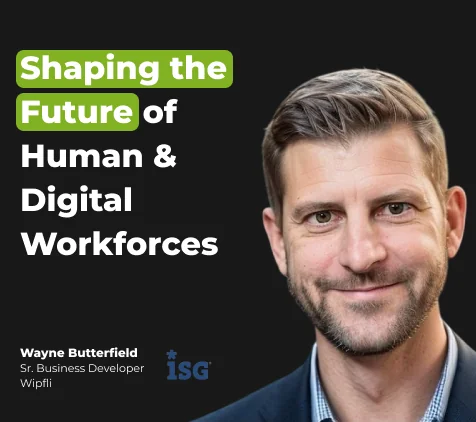Technology and Business Expansion: Mitch Knauf’s Path to Innovation
Join us for the newest episode of Martal Group Fireside Chats! Available now on YouTube and Spotify.
The relentless pace of technological change presents a major challenge for business leaders in today’s market. Staying ahead requires not only keeping up with new developments but also ensuring that these innovations align with strategic goals. To avoid rushed decisions that might not support long-term goals, meticulous planning, and clear objectives are essential in such a dynamic environment.
In this episode, we are joined by Mitch Knauf, an expert in strategic operations and innovation at Clio, who shares his insights on how businesses can navigate these complexities effectively.
In this episode, we discuss the following:
- The critical role of strategic alignment in technology adoption
- Techniques for fostering cross-departmental collaboration to enhance innovation
- The importance of setting clear objectives to guide technological integration
- How continuous learning and development can keep your team ahead of the curve
- Strategies for scouting and adopting cross-industry tech innovations
Below, you’ll discover some of the valuable strategies revealed in the interview to help your business not only keep up with but also lead in today’s rapidly evolving business field.
Getting to Know Mitch Knauf: A Visionary in Legal Technology
Mitch Knauf is the Director of Strategy and Operations at Clio, a prominent cloud-based legal technology company. In this role, Mitch is instrumental in steering the organization through rapid technological advancements in the legal sector. He applies his extensive expertise in strategy and operations to lead his team in identifying and capitalizing on new business opportunities, ensuring that Clio remains at the forefront of innovation in the legal sector.
Mitch’s approach to leadership is defined by his commitment to setting clear strategic goals and fostering an environment of cross-functional collaboration. His ability to drive cohesion among various departments helps Clio integrate technology solutions that enhance their service offerings seamlessly. This synergetic environment not only accelerates project timelines but also ensures that all strategic initiatives align with the company’s overarching objectives.
Under Mitch’s guidance, Clio continuously seeks to redefine the intersection of technology and legal services. His forward-thinking vision focuses on leveraging cutting-edge solutions to improve efficiency and accessibility in legal practices. Mitch’s leadership is pivotal in navigating the company through technological advancements and market shifts, making legal services more accessible and user-friendly for clients globally.
Core Insights to Revolutionize Your Business Practices
1) Embrace Curiosity and Discomfort
In roles centered around strategy and operations, embracing both curiosity and discomfort is fundamental. Mitch Knauf asserts that these traits are crucial for navigating the complexities and uncertainties inherent in these fields. Curiosity drives a deeper understanding and exploration of new strategies, while comfort with discomfort allows professionals to manage and adapt to the inevitable challenges and changes they will encounter.
Reflecting on his experience, Mitch offers this insight:


“What I’ve learned the most about being successful at a strategy and operations role is just being extremely curious and leaning in. My motto has always been, never say no and always embrace discomfort. All these things that you’re going to be jumping into, you can imagine the ambiguity is so fierce and you just got to go step by step, build out a plan and start executing it and have an impetus for action.”
Mitch Knauf
Embracing curiosity involves a continuous quest for knowledge and improvement, which can lead to innovative solutions that propel the organization forward. This mindset enables one to question the status quo and explore alternative methods and solutions that are not immediately obvious.
Discomfort, on the other hand, often signals growth opportunities. It pushes individuals to step out of their comfort zones, tackle new challenges, and acquire skills that are crucial in today’s ever-evolving business environment.
To implement this in a business setting, leaders should encourage a culture of inquiry and openness, where team members feel safe to express doubts and explore new ideas without fear of immediate rejection. Regular brainstorming sessions, workshops, and training can be instituted to nurture this culture. Additionally, setting up a structured system for experimentation where employees can test out new ideas on a small scale without significant risks could further embed this culture of curiosity and comfort with discomfort within the organization.
2) Enhance Cross-Departmental Cooperation
The goal of enhancing cross-departmental cooperation is to create a seamless operational flow that drives the company forward. By establishing a centralized strategy and integrating operations teams across each business segment, companies ensure that marketing, sales, customer success, and product development are fully integrated into the overall business strategy.
Mitch Knauf describes Clio’s approach to fostering teamwork as follows:


“We’re a centralized team that is mapped to each business segment… We are, for the most part, really in the operating rhythm of both the go-to-market teams, marketing, sales, customer success, as well as the product organization and understanding what’s on the forefront of their development. And we’re making sure that there’s continuity between all of that”
The centralized structure Mitch discusses promotes a unique synergy among the different departments, fostering a culture where continuous communication is the norm and strategic goals are clearly understood and actively pursued by all.
Regular updates and inter-departmental meetings are essential for maintaining the alignment and coherence that Mitch Knauf emphasizes. These meetings serve as a platform for open dialogue across departments, ensuring that each team is aware of and actively involved in the broader company strategy. They help identify operational bottlenecks and foster swift resolutions, thus maintaining a dynamic workflow that adapts to ongoing changes and challenges within the market.
Moreover, having synchronized goals that resonate across the company is critical for unified corporate progress. It cultivates a shared sense of purpose and drives collective action towards common objectives, thereby enhancing overall corporate efficacy and responsiveness to industry developments.
🔍 Looking for more ways to improve cross-department cooperation? Check out 5 Mistakes That Are Hurting Your Sales and Marketing Alignment
3) Refine Objectives and Performance Metrics
The precision of goal setting and the rigor of performance reviews are critical in ensuring alignment with overarching business objectives. Throughout our discussion, Mitch Knauf highlights the structured approach Clio takes through its OKR (Objectives and Key Results) program. The team’s systematic process serves to clarify goals across various levels of the organization while promoting a cohesive strategy primed for success.
As the director of strategy and operations, Mitch Knauf explains how alignment and continuous assessment drive strategic success:


“Our team also owns the OKR program, so goal setting, how do we make sure that those are both aligned tops-down, bottoms-up and sideways? And then, we run through business reviews. So we basically have an infrastructure or ritual put in place where we bring the leadership team together, we assess the performance of the business, and help basically course correct or drive prioritization on the tactics to ensure that we’re meeting our goals on that annual basis.”
By regularly assessing the progress toward Clio’s objectives, the leadership can make informed decisions about necessary course corrections. Such dynamic adjustments keep the company agile and responsive to both internal shifts and external market conditions.
When conducted effectively, performance reviews will go beyond mere evaluations to become strategic tools that foster open communication, mentorship, and goal alignment within a company. And when the process emphasizes constructive feedback and regular interactions between managers and team members, it can transform review sessions from a bureaucratic necessity to a cornerstone of organizational development.
4) Integrate Technology into Business Operations
Adapting to evolving technology in today’s business world is no longer an option but a necessity. Knauf highlights how many industries, traditionally slow in adopting new technologies, have begun to recognize the immense benefits of modern solutions. This pivotal shift, driven by the need for efficiency and enhanced capability, has revolutionized operational approaches.
Mitch reflects on the evolution of technology adoption within the legal sector:


“I think when we look back to where it was 10 years ago or so, you had a lot of resistance where, I think, smaller firms, for instance, felt like they didn’t need to invest in that technology or it was too pricey, it didn’t make sense for them… What happened over the last decade was really turning the corner on law firms basically being a lot more comfortable with cloud-based technology, a lot more receptive to the idea that they need to use technology to, again, reduce their admin time and be more utilized in their own role.”
This reflection reveals that overcoming initial barriers to technology adoption, such as cost concerns and reluctance to change, is essential for business growth. Businesses that have been quick to navigate these challenges successfully have realized significant gains in productivity and strategic advantage.
Of course, for technology integration to be successful, solutions must be user-friendly and secure. This ensures that all team members can adapt to new tools without extensive training or security risks. Companies should prioritize technologies that streamline operations and are easy to implement, focusing on solutions that offer the most immediate benefits in terms of time management and operational efficiency.
Being an early adopter of new technologies grants you that first-mover advantage, allowing you to capture a bigger market share and attract strategic partnerships. Organizations that quickly adapt to technological advancements often gain a competitive edge by setting market trends, improving efficiency, and enhancing customer engagement. This proactive approach involves not only equipping teams with the right tools but also continuously evaluating and updating technological resources to keep pace with industry trends and competitor movements.
5) Deliver an Exceptional Customer Experience
Customer expectations are continually growing, setting new benchmarks for service quality and responsiveness. Today’s prospects are more informed and have higher expectations for digital interactions; they demand convenience, speed, and personalization in every aspect of service. Mitch shows how understanding these shifting needs is crucial for any company aiming to excel in customer experience.
He explains Clio’s approach to customer service:


“We like to think of our product as being very user-friendly… We really lean into the customer support side too. We have email, chat, phone, a lot of other of our competitors don’t necessarily have all those channels. And our turnaround, we’re managing that very closely because we want to have that next-level customer experience. If you think about lawyers in this space, it’s extremely relationship-based, and what that means is that it’s very referral-based.”
Further enhancing customer experience involves consistent reliability and quality in every interaction. Companies that prioritize these aspects often see increased customer loyalty and positive word-of-mouth, which are invaluable in competitive markets. Maintaining high standards in customer service and product offerings encourages repeat business and helps in building a trusted brand reputation.
Excellent customer service functions as more than just a support mechanism — it’s a strategic asset that can drive market differentiation and growth. By proactively addressing customer feedback and continuously evolving service offerings, organizations can tap into new market segments and create opportunities for upscaling their services.
6) Establish Learning and Development Initiatives
Investing in continuous learning initiatives allows companies to proactively understand and anticipate market trends. This foresight is crucial in developing strategies that respond to current market conditions and predict future shifts both quickly and accurately. Consequently, businesses that prioritize learning are better equipped to innovate and maintain their market position, often outperforming rivals who react slower to new information.
While discussing this topic, Mitch Knauf explains their approach to continuous learning as follows:


“I’ve spent some time trying to work with my team to come up with what are the key sources of really good legal technology news that you can stay plugged into and understand. And we share that with our corporate development team who’s looking at mergers and acquisition opportunities. And we’re all trying to make sure that we’re staying abreast of this information and then sharing it across teams… There’s no harm in sharing something and getting a point of view. And so I encourage that with my team, and I like to try to lead by example too, where other departments are sharing that information and it’s sparking ideas and new ways in which we’re working together with our customers.”
Mitch Knauf’s emphasis on sharing information across teams highlights the value of a collaborative learning environment. By pooling resources and insights from various departments, organizations can create a rich knowledge base that benefits all employees. This culture of knowledge sharing won’t only enhance individual capabilities but also drive collective organizational growth. Encouraging open discussions and regular information exchange will lead to innovative solutions and more cohesive teamwork.
However, staying informed requires leveraging a variety of external knowledge sources. Companies should identify key industry publications, thought leaders, and relevant news outlets that provide valuable insights. As you integrate these sources into regular team updates and discussions, you’ll guarantee that everyone is staying current with the latest trends and developments.
Continuous education will foster innovation by encouraging employees to think critically and creatively. When team members are regularly exposed to new ideas and perspectives, they are more likely to develop innovative solutions to business challenges. These can include regular training sessions, workshops, and seminars focused on emerging trends and skills relevant to the industry.
7) Scout Other Industries for Cutting-Edge Tech Adaptations
Embracing technology from various sectors can be a game-changer for industries traditionally slow in adopting new innovations. By scouting advancements in fields such as finance, healthcare, and technology, businesses can revolutionize practices that have long been untouched by modernization.
Mitch Knauf shares insights on adapting technology trends to the legal sector:


“The legal industry, in general, is just not an early adopter of technology, and so it’s really exciting because you can see the same trends that happen across other industries where we are in those same trends being applied to the legal industry, with the compounded change of AI. And so there’s not going to be the exact same motion that the industry goes through that others went through. Trying to map that out and think about it is really fun. And I think that’s where… how all the players within the industry are up-leveling their use of technology.”
Developing a systematic approach to technology scouting involves regular reviews of technological advancements outside one’s industry, attending cross-industry conferences, and engaging with thought leaders from diverse fields.
For successful implementation, it’s essential to systematically evaluate how these technologies have impacted other industries and to consider potential applications within one’s own. Regular strategic reviews, pilot projects, and partnerships with tech pioneers can facilitate this integration, ensuring that adaptations are both practical and forward-thinking.
Incorporating technologies such as AI and machine learning from sectors that have successfully harnessed these tools can lead to significant efficiencies and innovation. By observing and adapting these technologies, the legal industry — for example — can dramatically enhance its operational capabilities. This process involves not just adoption but also a tailored transformation to meet specific industry needs.
8) Harness AI to Drive Innovative Solutions
Imagine a world where AI not only supports but leads the charge in redefining how tasks are performed.
In this interview, Mitch Knauf discussed the transformative power of AI in document drafting and workflow management, where mundane tasks become automated and the real magic of innovation begins.
When asked about Clio’s approach to integrating AI solutions, Knauf shared the following insights:


“With the combination of where AI is and where we see a lot of lawyers spending a lot of their time, it’s in drafting documents and generating documents… We’re continuously iterating and trying to think about how AI and workflow management can create a very unique value that not many other players can. And we think about owning the workflow. We have a right to probably have the most data around how lawyers are working day to day, and we could really leverage that information to build a very unique experience”
As Mitch exemplifies, enterprises have the opportunity to perfect existing processes, discover new ways to serve their clients, and stay ahead in competitive markets all by harnessing the power of AI. Organizations that adopt AI early can shape market trends and establish benchmarks that set them apart from the competition.
The trajectory for AI in business points to a future where its integration is expected and essential. Companies that are early adopters of AI will set the pace and define the future of their industries.
Embracing AI today is an investment in becoming a market leader tomorrow, where the focus shifts from simply doing better to doing what was once thought impossible.
Wrap-Up: What We’ve Learned
Our interview with Mitch Knauf offers a deep dive into the transformative power of technology in modern business environments, highlighting several strategies for leveraging technology and fostering innovation. By embracing curiosity and discomfort, companies are able to cultivate a mindset open to growth and problem-solving. This approach, combined with enhancing cross-departmental cooperation, ensures cohesive teamwork and strategic alignment.
Refining objectives and performance metrics is also critical for maintaining focus and aligning efforts with overarching sales goals. When an enterprise begins to integrate technology into operations, it not only streamlines its processes but also significantly boosts efficiency, underscoring the importance of technological agility in today’s market.
As you implement these strategies in your organization, remember that success lies in being adaptable, open to new ideas, and proactive in leveraging technological advancements. By fostering a culture of continuous learning and innovation and by looking beyond your industry for inspiration, you’ll ensure that your business remains not just competitive but a step ahead in a constantly shifting business environment.
💡Want more? Check out the Ultimate Sales Advice Blueprint, featuring expert tips from top revenue leaders worldwide that will help you accelerate your business growth.


